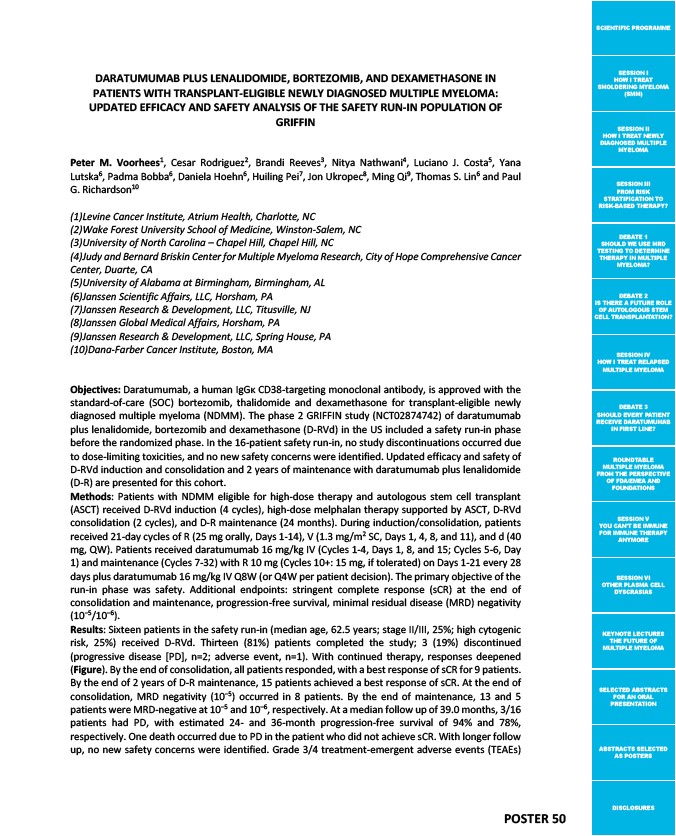
SCIENTIFIC PROGRAMME
SESSION I
HOW I TREAT
SMOLDERING MYELOMA
(SMM)
SESSION II
HOW I TREAT NEWLY
DIAGNOSED MULTIPLE
MYELOMA
SESSION III
FROM RISK
STRATIFICATION TO
RISK-BASED THERAPY?
DEBATE 1
SHOULD WE USE MRD
TESTING TO DETERMINE
THERAPY IN MULTIPLE
MYELOMA?
DEBATE 2
IS THERE A FUTURE ROLE
OF AUTOLOGOUS STEM
CELL TRANSPLANTATION?
SESSION IV
HOW I TREAT RELAPSED
MULTIPLE MYELOMA
DEBATE 3
SHOULD EVERY PATIENT
RECEIVE DARATUMUMAB
IN FIRST LINE?
ROUNDTABLE
MULTIPLE MYELOMA
FROM THE PERSPECTIVE
OF FDA/EMEA AND
FOUNDATIONS
SESSION V
YOU CAN’T BE IMMUNE
FOR IMMUNE THERAPY
ANYMORE
SESSION VI
OTHER PLASMA CELL
DYSCRASIAS
KEYNOTE LECTURES
THE FUTURE OF
MULTIPLE MYELOMA
SELECTED ABSTRACTS
FOR AN ORAL
PRESENTATION
ABSTRACTS SELECTED
AS POSTERS
DISCLOSURES
DARATUMUMAB PLUS LENALIDOMIDE, BORTEZOMIB, AND DEXAMETHASONE IN
PATIENTS WITH TRANSPLANT-ELIGIBLE NEWLY DIAGNOSED MULTIPLE MYELOMA:
UPDATED EFFICACY AND SAFETY ANALYSIS OF THE SAFETY RUN-IN POPULATION OF
POSTER 50
GRIFFIN
Peter M. Voorhees1, Cesar Rodriguez2, Brandi Reeves3, Nitya Nathwani4, Luciano J. Costa5, Yana
Lutska6, Padma Bobba6, Daniela Hoehn6, Huiling Pei7, Jon Ukropec8, Ming Qi9, Thomas S. Lin6 and Paul
G. Richardson10
(1)Levine Cancer Institute, Atrium Health, Charlotte, NC
(2)Wake Forest University School of Medicine, Winston-Salem, NC
(3)University of North Carolina – Chapel Hill, Chapel Hill, NC
(4)Judy and Bernard Briskin Center for Multiple Myeloma Research, City of Hope Comprehensive Cancer
Center, Duarte, CA
(5)University of Alabama at Birmingham, Birmingham, AL
(6)Janssen Scientific Affairs, LLC, Horsham, PA
(7)Janssen Research & Development, LLC, Titusville, NJ
(8)Janssen Global Medical Affairs, Horsham, PA
(9)Janssen Research & Development, LLC, Spring House, PA
(10)Dana-Farber Cancer Institute, Boston, MA
Objectives: Daratumumab, a human IgGκ CD38-targeting monoclonal antibody, is approved with the
standard-of-care (SOC) bortezomib, thalidomide and dexamethasone for transplant-eligible newly
diagnosed multiple myeloma (NDMM). The phase 2 GRIFFIN study (NCT02874742) of daratumumab
plus lenalidomide, bortezomib and dexamethasone (D-RVd) in the US included a safety run-in phase
before the randomized phase. In the 16-patient safety run-in, no study discontinuations occurred due
to dose-limiting toxicities, and no new safety concerns were identified. Updated efficacy and safety of
D-RVd induction and consolidation and 2 years of maintenance with daratumumab plus lenalidomide
(D-R) are presented for this cohort.
Methods: Patients with NDMM eligible for high-dose therapy and autologous stem cell transplant
(ASCT) received D-RVd induction (4 cycles), high-dose melphalan therapy supported by ASCT, D-RVd
consolidation (2 cycles), and D-R maintenance (24 months). During induction/consolidation, patients
received 21-day cycles of R (25 mg orally, Days 1-14), V (1.3 mg/m2 SC, Days 1, 4, 8, and 11), and d (40
mg, QW). Patients received daratumumab 16 mg/kg IV (Cycles 1-4, Days 1, 8, and 15; Cycles 5-6, Day
1) and maintenance (Cycles 7-32) with R 10 mg (Cycles 10+: 15 mg, if tolerated) on Days 1-21 every 28
days plus daratumumab 16 mg/kg IV Q8W (or Q4W per patient decision). The primary objective of the
run-in phase was safety. Additional endpoints: stringent complete response (sCR) at the end of
consolidation and maintenance, progression-free survival, minimal residual disease (MRD) negativity
(10−5/10−6).
Results: Sixteen patients in the safety run-in (median age, 62.5 years; stage II/III, 25%; high cytogenic
risk, 25%) received D-RVd. Thirteen (81%) patients completed the study; 3 (19%) discontinued
(progressive disease PD, n=2; adverse event, n=1). With continued therapy, responses deepened
(Figure). By the end of consolidation, all patients responded, with a best response of sCR for 9 patients.
By the end of 2 years of D-R maintenance, 15 patients achieved a best response of sCR. At the end of
consolidation, MRD negativity (10−5) occurred in 8 patients. By the end of maintenance, 13 and 5
patients were MRD-negative at 10−5 and 10‒6, respectively. At a median follow up of 39.0 months, 3/16
patients had PD, with estimated 24- and 36-month progression-free survival of 94% and 78%,
respectively. One death occurred due to PD in the patient who did not achieve sCR. With longer follow
up, no new safety concerns were identified. Grade 3/4 treatment-emergent adverse events (TEAEs)